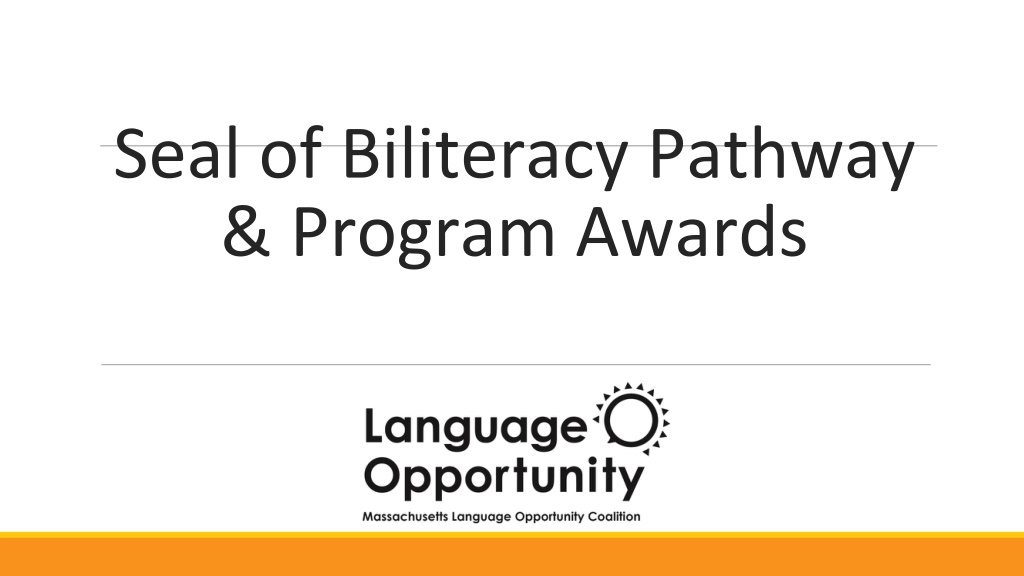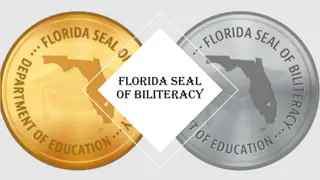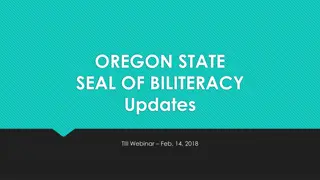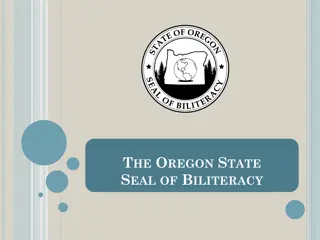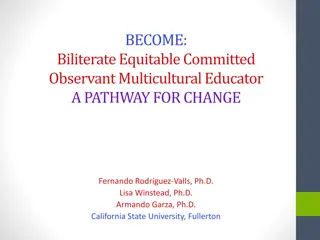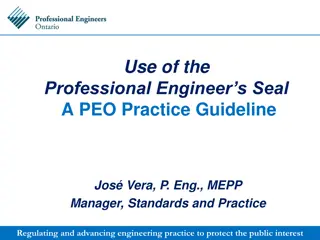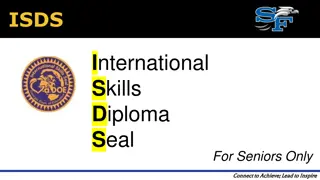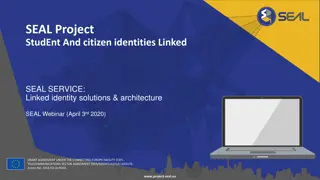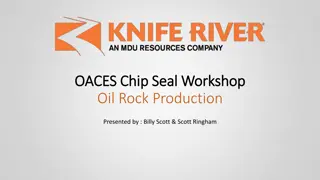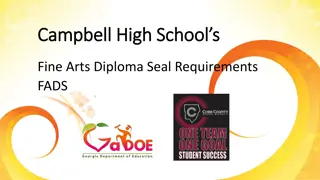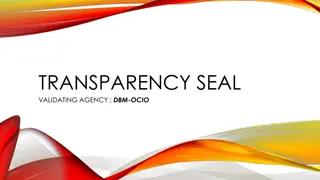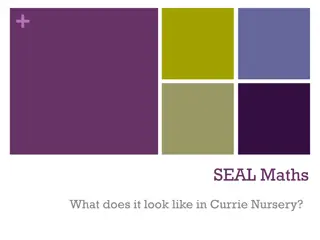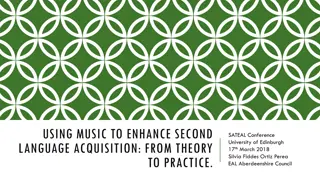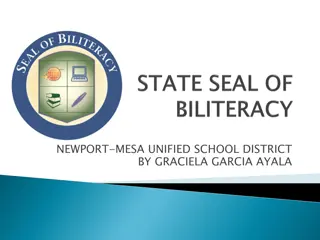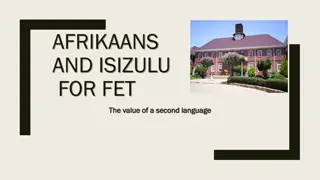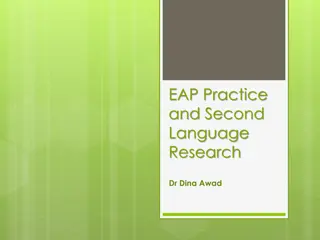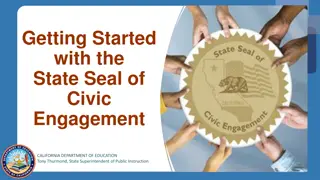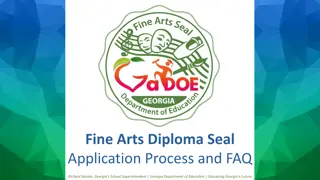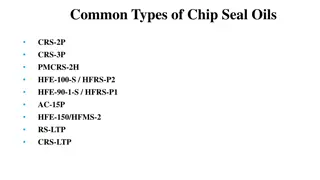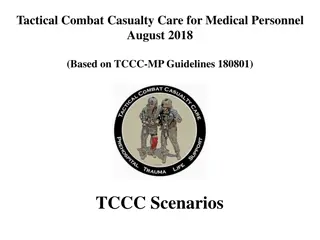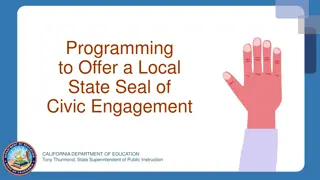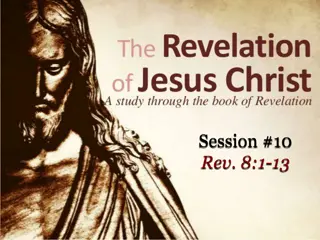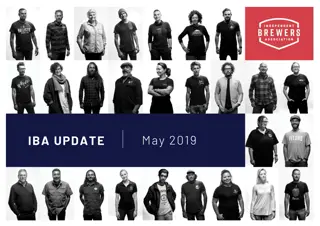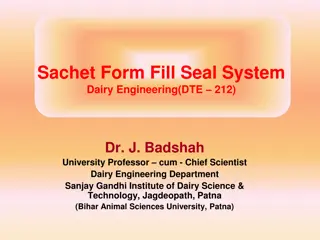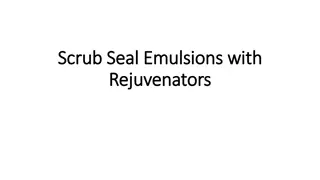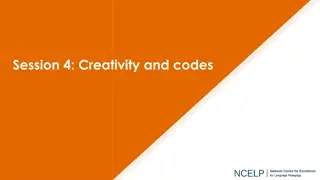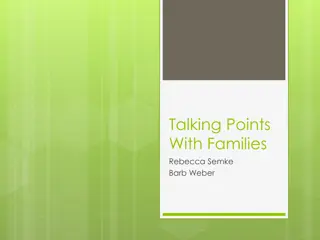Benefits of the Seal of Biliteracy and Learning a Second Language
The Seal of Biliteracy recognizes students proficient in multiple languages, promoting global competence, cognitive benefits, and employability. Learning a second language fosters critical thinking, cultural understanding, and opens doors to diverse opportunities in the increasingly interconnected world.
Download Presentation

Please find below an Image/Link to download the presentation.
The content on the website is provided AS IS for your information and personal use only. It may not be sold, licensed, or shared on other websites without obtaining consent from the author. Download presentation by click this link. If you encounter any issues during the download, it is possible that the publisher has removed the file from their server.
E N D
Presentation Transcript
Seal of Biliteracy Pathway & Program Awards
What is the Seal of Biliteracy? The Seal of Biliteracy is an award given by a school or district in recognition of students who have studied and attained proficiency in speaking, reading, and writing in two or more languages by high school graduation.
Why Should Students Learn a Second Language? In order for all students to thrive and succeed in the 21st century, we must cultivate students understanding of the complex, diverse and interdependent world in which they live. Research shows that becoming bilingual has long- term cognitive, cultural and economic benefits.
What Does It Mean To Be Globally Competent? Children who are learning two languages and who have a familiarity with one or more cultures different from their own have the advantage of understanding the viewpoint of others and recognizing the importance of communicating effectively when tackling issues across the globe. The study of languages and cultures enables students to think more critically and creatively. Students abilities to understand and adapt to a changing world are the foundation for global competence.
Skills Attractive to Future Employers In one survey of human resource managers, participants reported that proficiency in a foreign language was a consideration in hiring decisions at 42 percent of firms, and 66 percent considered it in making retention decisions. Yes 42% Yes 66% Source: Committee on Economic Development, 2006, p. 17
Civil Rights Project CA Labor Market Survey 2012 In every industry, bilingualism was a desirable trait for some or all positions. Overall about 66% of the employers responded that they would prefer a bilingual employee over a monolingual English speaker if they were comparable in other respects. There was some variation by job sector.
What We Hope The Seal of Biliteracy encourages students to pursue biliteracy, honors the skills students attain, can be evidence of skills that are attractive to future employers and college admissions offices, and viewed as an asset.
Who Awards the Seal of Biliteracy? The Seal of Biliteracy was designed to be awarded by school districts; however, an individual school site or school program may also decide to implement the award.
Why Pilot the Seal of Biliteracy? Purpose for instituting Pathway Awards: To promote the learning of languages in addition to English To encourage enrollment in language learning opportunities and programs To shape initial attitudes and inform children about language diversity To prepare students with 21st century skills that will benefit them in the labor market and the global society
Communicating the Purpose, Rationale & Pathways Awards Clarify for your school, community and district the purpose for giving the Awards and articulate the frame and rationale for how the skills of bilingualism have value. The specific purposes and rationale lead to the creation of a school or district policy. The policy articulates how and why language diversity is important. Communicate to all stakeholders the commitment, planning, time and ultimate competency that is involved to embark on the Pathway Awards.
Program Types Foreign Language/World Language Study Programs/Courses PreK-12 and College Dual Language Education (Immersion) Programs PreK - 12 FLES - Foreign Language in Elementary School Traditional World Language Classes Spanish (or native language) for Native Spanish (Native Language) Speakers Study Abroad/Exchange Program After School, Summer or Weekend Language Programs FLEX - Foreign Language Experience Two-Way Immersion (TWI) One-Way, Heritage or Foreign Language Immersion (OWI) Developmental Bilingual Transitional Bilingual Education (TBE) Programs Newcomer Programs
Pathway Awards Biliteracy Attainment Award Low-Intermediate Level Elementary School Mid-Intermediate Level Middle & High School Silver Seal Award High-Intermediate Level High School Gold Seal Award High School or College Platinum Seal Award Low-Advanced Level
Required Criteria English: Proficient or higher on standardized state assessment (ACCESS, MCAS) Partner Language: Specific proficiency level on standardized assessment in a language other than English Portfolio: Documentation of 3 5 benchmark pieces of classwork and projects of interpersonal communication, interpretive communication, and presentational communication
Assessment Instruments Advanced Placement (AP) International Baccalaureate (IB) Aventa Online Advanced Placement (AP) Courses Standards-based Measurement of Proficiency (STAMP) ACTFL AAPPL Aprenda SOPA SOLOM DRA
Optional Criteria Districts may elect to include additional criteria, for example: Completion of a set number of hours of community service using primary language skills in service to the school or community and demonstrating the ability to use translation in social situations; Reading logs signed by their teachers of ten books (at grade level) read independently in English and ten books (at grade level) read independently in a language other than English. A written paper in two languages (translation) with a rubric score of 4 or above at the 5th grade level; A written essay on why bilingualism is important to them personally, to their community, and to the world; Oral presentation about five careers where bilingualism is important and why and how bilingualism is a benefit in those careers
Optional Criteria For ELLs Suggested criteria by San Francisco, CA School Attendance for 3 (elementary) or 5 (secondary) + years in country of origin Reclassified as Former ELL (Level 5 or 6 Composite Score on WIDA ACCESS)
Competencies Low Intermediate Mid Intermediate High Intermediate Low Advanced Interpretive Reading: I can understand the main idea of short and simple texts when the topic is familiar. Interpretive Reading: I can understand the main idea of texts related to everyday life and personal interests or studies. Interpretive Reading: I can easily understand the main idea of texts related to everyday life, personal interests, and studies. I can sometimes follow stories and descriptions about events and experiences in various time frames. Interpretive Reading: I can understand the main idea and some supporting details on a variety of topics of personal and general interest. I can follow stories and descriptions of some length and in various time frames and genres. Presentational Writing: I can write briefly about most familiar topics and present information using a series of simple sentences. Presentational Writing: I can write on a wide variety of familiar topics using connected sentences. Presentational Writing: I can write on topics related to school, work, and community in a generally organized way. I can write some simple paragraphs about events and experiences in various time frames. Presentational Writing: I can write on general interest, academic, and professional topics. I can write organized paragraphs about events and experiences in various time frames. Presentation Speaking: I can present information on most familiar topics using a series of simple sentences. Presentation Speaking: I can make presentations on a wide variety of familiar topics using connected sentences. Presentation Speaking: I can make presentations in a generally organized way on school, work, and community topics, and on topics I have researched. I can make presentations on some events and experiences in various time frames. Presentation Speaking: I can deliver organized presentations appropriate to my audience on a variety of topics. I can present information about events and experiences in various time frames.
Competencies Low Intermediate Mid Intermediate High Intermediate Low Advanced Presentation Speaking: I can present information on most familiar topics using a series of simple sentences. Presentation Speaking: I can make presentations on a wide variety of familiar topics using connected sentences. Presentation Speaking: I can make presentations in a generally organized way on school, work, and community topics, and on topics I have researched. I can make presentations on some events and experiences in various time frames. Presentation Speaking: I can deliver organized presentations appropriate to my audience on a variety of topics. I can present information about events and experiences in various time frames. Interpersonal Communication: I can participate in conversations on a number of familiar topics using simple sentences. I can handle short social interactions in everyday situations by asking and answering simple questions. Interpersonal Communication: I can participate in conversations on familiar topics using sentences and series of sentences. I can handle short social interactions in everyday situations by asking and answering a variety of questions. I can usually say what I want to say about myself and my everyday life. Interpersonal Communication: I can participate with ease and confidence in conversations on familiar topics. I can usually talk about events and experiences in various time frames. I can usually describe people, places, and things. I can handle social interactions in everyday situations, sometimes even when there is an unexpected complication. Interpersonal Communication: I can participate in conversations about familiar topics that go beyond my everyday life. I can talk in an organized way and with some detail about events and experiences in various time frames. I can describe people, places, and things in an organized way and with some detail. I can handle a familiar situation with an unexpected complication.
Awarding Biliteracy Which of these awards would you like to implement? Elementary School: Biliteracy Attainment Award Middle School: Silver Seal of Biliteracy Award High School: Silver Seal of Biliteracy Award High School: Gold Seal of Biliteracy Award High School/College: Platinum Seal of Biliteracy Award
Pilot Implementation Expectations Follow criteria for the specific award Provide the names of students receiving the Seal, the language(s) of biliteracy, the standardized assessment used for assessing English and the partner language, and the language learning program student enrolled Participate in training for Rubric for Portfolio & submit exemplar samples of Portfolios For Middle and High School, provide a list of available or offered language courses with the proficiency level for the course Consider applying for Distinguished Program Award
Distinguished Program Awards Preschool: Pursuit of Becoming Bilingual Program Award Elementary: World Language Program Award or Two-Way Bilingual Program Award Middle School: World Language Program Award or Two- Way Bilingual Program Award High School: World Language Program Award or Two-Way Bilingual Program Award
Distinguished Program Awards Proposed Rubric for Two-Way Bilingual Program Award CAL Guiding Principles for Dual Language Education Exemplary Practice Proposed Rubric for World Language Program Award Pennsylvania State Modern Language Association PEP Award rubric - adapted sections
States with the Seal of Biliteracy 22 other states have already adopted or are in the process of adopting a state Seal of Biliteracy Several states have made expanded language learning a centerpiece of their educational policy. Surprisingly, Massachusetts, THE leading EDUCATIONAL state in the country, has not led this charge towards effective multilingualism in a global world.
Resources Follow progress of the Seal of Biliteracy at www.SealOfBiliteracy.org Hear a Podcast about the Seal of Biliteracy legislation and use in schools: www.pri.org/stories/2014-12-10/enter-school-s-raising-bar- bilingual-ed Learn more about national Biliteracy guidelines: http://awww.actfl.org/news/press-releases/seal-biliteracy- guidelines-released
Language Opportunity Coalition We are a coalition of students, parents, community members, teachers, activists, and community groups. Restrictive language education policies have resulted in a lack of equitable educational opportunities for language learners in Massachusetts. We believe that language and cultural competence are resources to be invested in and valued, and are essential for a strong economy and a just society. We aspire to increasing bilingualism, biliteracy, and multicultural understanding as assets that enhance social and economic growth within a global economy. Our goals are to Increase language learning opportunities for learning English, developing and/or maintaining a native/heritage language, or learning a foreign language. Ensure that all learners have equal access to a high quality education and professional opportunities
Acknowledgements Seal of Biliteracy Workgroup Members Language Opportunity Coalition Steering Committee Jorge Allen, Andover Terry Caccavale, Holliston Maria Campanario, Boston Katie Cardamone, Mendon-Upton Adria Cohen, Millis Kristina Dahlen, Sharon Pat DiPillo, Falmouth Tim Eagan, Wellesley Madelyn Gonnerman Torchin, UMASS Boston Phyllis Hardy, MABE Rita Oleksak, Glastonbury Vula Roumis, Brockton Catherine Ritz, Arlington Cristina Sandza-Donovan, Framingham Nicole Sherf, MAFLA Kim Talbot, Melrose Dania Vazquez, Boston Ronie Webster, Monson Shannon Erwin, Massachusetts Immigrant and Refugee Advocacy Coalition (MIRA) http://miracoalition.org/ Phyllis Hardy, Massachusetts Association for Bilingual Education (MABE) http://www.massmabe.org/ Nicole Sherf, Massachusetts Foreign Language Association (MA FLA) http://mafla.org/ Helen Solorzano, Massachusetts Educator of English Language Learners (MATSOL) http://www.matsol.org/ Language Opportunity Coalition http://languageopportunity.org/
Multiple Paths to Multilingualism Foreign Language/World Language Study Programs Foreign Language/World Language Study Programs Dual Language Programs K-5/6 6-12 K-12 Foreign Language in Elementary School (FLES Traditional world language classes in middle and high school One Way Immersion/Foreign Language Immersion/Heritage Language Immersion Foreign Language Experience (FLEX) Spanish for Native Spanish Speakers Two Way Immersion After school or weekend language programs Study Abroad Developmental Bilingual Transitional Bilingual Education College Major or Minor in World Languages and Study Abroad
